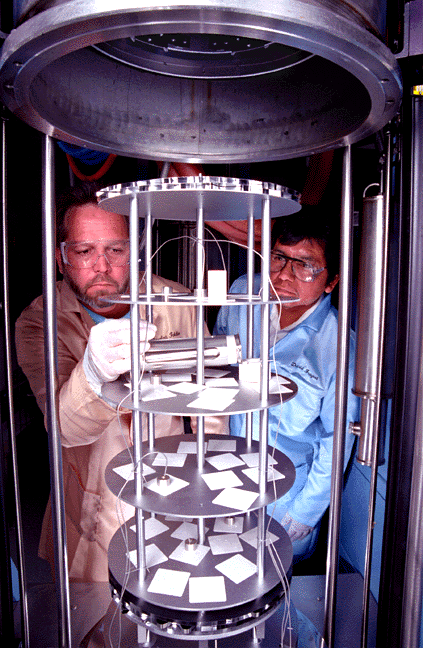
subassemblies for joining in a computer-controlled and electrically
heated hydrogen furnace. The hydrogen atmosphere eliminates
oxidation of metal piece parts.
They don’t make cookies — the round silicon wafers used for microcircuits — there anymore, but Sandia National Laboratories’ “cookie factory,” is back in the production business. The 91,000-square-foot Neutron Generator Facility, which emerged out of the remains of the cookie factory in a $25 million remodeling/rebuilding project, was officially dedicated in an April 11 ceremony.
Sandia was assigned production responsibility for neutron tubes and neutron generators in the fall of 1993. Neutron tubes and generators are vital components of US nuclear weapons and they must be replaced periodically (see below, “Manufacturing neutron tubes, generators an exacting process”).
As Chuck Loeber (formerly DOE/AL, Weapons Quality Division) has written: “After the Cold War ended, the DOE complex no longer needed to be as large as it had been. There would be no new weapons production . . . . [A DOE/AL reconfiguration study] recommendation was to close Mound, Pinellas, and Rocky Flats.”
Sandia has always had design and prototyping responsibility for neutron tubes and generators, but the production had previously been carried out at DOE’s Pinellas (Fla.) facility. When Pinellas closed, personnel, equipment, and inventory were moved to Sandia to help the Labs carry out its new tasks.
Larry Pope, Manager of the Analytical Services Dept. and a Sandia representative on the DOE/AL reconfiguration study, credits the former Pinellas personnel with making the transfer of production responsibilities as smooth as it has been.
“We identified 87 [Pinellas] positions that entailed critical skills we needed if we were to succeed in this mission,” Pope says. “We successfully recruited 84 people — and all the critical skills. Those folks are here now and by and large, they’ve been very enthusiastic about the move. They’ve been vitally important to what we’re trying to do here and are a major contributing force to the fact that we’re on schedule with this process.”
The schedule Pope refers to has been a demanding one. Consider: the building project was authorized in September 1993, shortly after Sandia was handed the production mission. The building design was approved in June 1994, with contracts awarded in September 1994. The general contractor, Henderson Construction, completed the facility in January 1996, 30 days ahead of schedule and within budget.
While the new construction was progressing, Sandia’s Defense Programs Products and Services Division was simultaneously gearing up for its production mission. Design work on a next-generation neutron generator and tube proceeded in parallel with construction. Sometimes, the construction was literally occurring side by side with design and prototyping work.
“We actually moved into the east annex [wing] a year ago,” Pope says, “and into the west annex last August. “The challenge has been to keep to the neutron tube and generator production schedule while making this major move. We — Sandia — have done that. We’re on the same schedule [for the new tube and generator] as we would have been if production had stayed at Pinellas.”
Manufacturing neutron tubes, generators an exacting process
A neutron tube can be thought of as a small linear accelerator. High reliability, miniaturization, and high-voltage requirements call for the use of exotic materials and advanced processes during manufacture. Materials used in neutron tubes include molybdenum, rare earth metals, high purity alumina ceramics, and cermets (a conductive alumina/metal blend).
Processing of neutron tubes calls for environmentally compatible cleaning, metal plating, ceramic-to-metal bonding, high-precision welding, thin-film deposition of rare earth metals, and ultrahigh vacuum technologies. High voltage and the need for controlling particulate contamination require many manufacturing processes to be performed in “Class 100” clean rooms.
The neutron generator consists of a neutron tube and a power supply to operate it. Neutron tubes contain tritium that decays over time. As such, neutron generators are limited-life components and must be replaced at regular intervals. The neutrons emitted from a generator are used to initiate the fission reaction in nuclear weapons. The generation of neutrons is accomplished by the fusion of isotopes of hydrogen (deuterium and tritium) by ion acceleration.
The assembled neutron generator is encapsulated in two different resin/filler systems. An epoxy/aluminum oxide mixture is poured around the ceramic power supply as a shock-propagating material. A rubber modified epoxy/glass microballoon mixture is poured around the tube as a shock mitigating material. A gradient cure process is used for stress level control: a temperature gradient of only 1015 degrees across the mold reduces curing stresses produced by resin shrinkage. This new curing technology increases product yields. Final neutron generator acceptance tests are performed on sophisticated electronic product testers. Tests and evaluations assure that the neutron generators function to specifications and have high reliability.